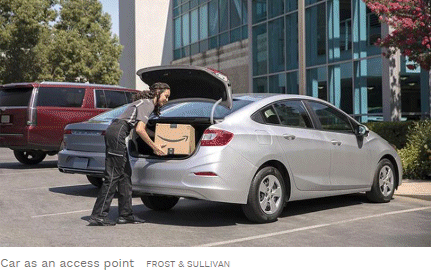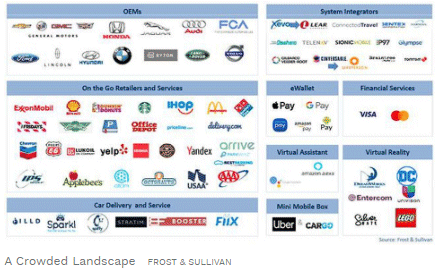Let’s start with two things that happen quite frequently to me: an empty tank and an empty fridge. I believe these might soon be a thing of the past, thanks to an unexpected ally…my car.
Here’s how: my car will alert me when the petrol is running low, help me navigate to a conveniently located fuel station that offers competitive prices, and let me pay in advance. This means, of course, that I will be able to zip in, top up, and zip out without ever having to step out of the car or queue up to pay. As for the empty fridge, while I drive home, the digital assistant in my car will communicate a list of required grocery items to my regular grocery store with instructions that they be waiting at my doorstep before I reach home.
And now the clincher: this scenario is not from some distant future, it’s happening here and now as cars transform into buzzing, throbbing mobile marketplaces.
A Transaction Center On Wheels
In-car commerce or the ‘car as a marketplace’ concept promises to profoundly transform the universe of transactions, enabling us to reserve, order and buy everything within an enroute journey.
These range from searching for fuel stations and paying for fuel, identifying convenient parking spaces with real-time prices, and paying for tolls to upgrading auto packages, getting quotes for car accessories/spare parts and scheduling car repairs. The options are just as good for your personal needs. How about being able to pre-order and pay for food, coffee, and groceries and, in some cases, even get them home delivered? Add to that the ability to make restaurant reservations and hotel bookings from the comfort of your car. And if that isn’t enough, having your car alert you to location- based discounts and deals being offered by your favorite brands and stores as you drive along your preferred route.
No wonder then that almost $17 billion in routine and leisure consumer spending is estimated to be generated by integrated, in-vehicle marketplace applications by 2025. And all it will take to lighten your wallet and list of tasks for the day is a touch on your car dashboard, a press of a button on your steering wheel, a voice command to your virtual assistant or even just a simple thumbs up sign.
Four Major Use Cases Are Emerging
Car as a marketplace is not just about improving a single user’s retail experience, instead, it’s about the myriad other possibilities that open up by making the car a high octane, transactional hub.
First and foremost, there’s the example of the entertainment touchscreen acting as an access point to roadside retailers. For instance, General Motors’ built in app called Marketplace in the US, allows digital payments and pre-booking along with a customized list of options based on the frequency with which a certain product/service is ordered. Honda with DreamDrive is preparing to follow a similar touchscreen placement, with additional offerings for rear seat passengers. Here, among other things, it will keep children seated in the rear seat engaged with educational and entertainment content.
Another example is the car as a virtual assistant, where voice-enabled, virtual assistants – either standalone, tethered or embedded into the car – can help with daily tasks, routing and shopping, and bring next generation contextual responses compared to only touchscreen use cases. The in-vehicle virtual assistant can also synch with home control devices to adjust temperature and light controls at home.
They can also prepare to do lists, connect to the office calendar and arrange meetings, order groceries, reorder and have office supplies picked up, call roadside assistance, schedule vehicle maintenance appointments, navigate to the most convenient and cost-effective gas station and much, much more.
Amazon’s Alexa, for instance, enables marketplace in cars through contextual voice commands and responses supported by the car’s touchscreen. It has thousands of skills, which include finding the cheapest gas and most convenient parking.
The other aspect I’m intrigued about is how far the concept of ‘car as an access point of service’ will evolve. This idea centers on having your car become a hub to which a range of services can be delivered. Package delivery is one obvious service. Here a mobile app would allow the car to be remotely locked/unlocked and deliveries made when the car is parked in a public area. GM and Volvo already have Key for Amazon that enables such in-car package deliveries.
Similarly, Filld, Booster and Yoshi offer fuel delivery to parked cars. Sparkl, Spiffy and the recently KAR Auction Services acquired Stratim give your car a nice wax and shine right where they are parked. Wrench and Fiix are bringing auto care—such as oil or tire change and worn/torn parts maintenance services—to your vehicle.
Another way in which I see the car as marketplace generating revenues is where it is positioned as a mini mobile store. In this concept, drivers for ride hailing cars install a box in their cars and have goods delivered to them on a regular basis. On receiving notification of an order, they deliver the order to the customer. For drivers it is an easy, no-frills way to earn some extra money. For retailers, it’s a dynamic platform from which to sell their goods. For customers, this mini mobile store is a convenient way to purchase snacks, beverages, and electronic items. DriveCargo, a start-up, has been quick off the blocks with its boxes installed into Uber cars.
The Benefits Flow In Many Directions
With so many opportunities on offer, it’s little wonder that the ecosystem is packed with car manufacturers, platform providers, payment companies, virtual assistants, retailers and service providers all of whom want a slice of the action and the revenues.
While it’s a fast developing space, General Motors is currently the only car manufacturer that actively offers multiple in-vehicle marketplace solutions like fuel, food, parking, accommodation, road side pickup and access to car products and updates. Audi enables toll payments in the U.S. and Canada, Jaguar Land Rover and Yandex allow in-car fuel purchases in the U.K. and Russia, respectively. BMW has launched the concept of subscription-based offers on CarPlay, while Mercedes Benz MBUX showcases the commoditization of connected services. Meanwhile, the race looks set to hot up as Honda, Ford, FCA, and Hyundai step up beta testing of their in-car marketplace operations in anticipation of their imminent launch.
Today, Xevo and Connected Travel lead in the platform providers’ stakes, while Apple CarPlay, Visa, PayPal, Google Pay and Amazon Pay are active in the payment game. Retailers, needless to add, have been quick off the mark. This rapidly expanding list already includes GrubHub, McDonalds, Exxon, Shell, ParkWhiz, Priceline.com, and Office Depot, among many others.
Who Said Cars Were Only For Driving?
Selfish motivations aside, my team at Frost & Sullivan and I are very bullish about the prospects of car as a marketplace. Not only do I expect the number of active users of in-car commerce to increase, I also expect the capabilities and the range of products/services on offer to proliferate. I anticipate the concept to gain adherents among ride hailing customers, casual drivers, public transportation users and fleet operators as they begin to realize its many benefits.
I foresee payments moving from being segregated according to different merchants’ requirements to clustering onto a central payment platform. This will remove the need for device switching, making it simpler and more convenient to make purchases.
I believe car manufacturers will expand their range of in-vehicle contextual services—where applications are responsive, rather than static—in order to boost brand loyalty and strengthen customer engagement. The opportunities to monetize driver data will be enormously attractive to them. At the same time, they will have the chance to attract a new customer segment that is focused not so much on how cars look but how they behave i.e., function over form.
Similarly, I think that retailers will embrace the new digital sales channels and revenue opportunities opened up by this concept. I know customers (like me) will mostly be seduced by the prospect of a continuous stream of promotional deals and information tailored to their personal preferences, by the efficient fulfilment of routine daily tasks, and by options that make life easier (no more empty fridges or depleted fuel tanks). I also believe that stakeholders, like technology companies, will be vested in in-vehicle commerce because of the array of new revenue streams that it represents.
So who said cars were only for driving?
Article was originally published on Forbes.com





